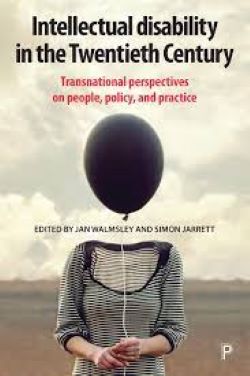Clare Palmer is impressed by a study which charts the twentieth-century history of learning disability in twelve countries across the world

Intellectual Disability in the Twentieth Century: Transnational perspectives on people, Policy and Practice.
Author:
Jan Walmsley & Simon Jarrett
Publisher:
Policy Press, 2019, 216 pp.
Price:
Paperback £26.99
e-book £26.99
ISBN:
——–
Jan Walmsley and Simon Jarrett (editor of Community Living Magazine) have jointly edited this book. It is a remarkable achievement. As they say in their introduction: “We believe it is the first of its kind to take a historical view of policy and practice in intellectual disability across continents, and we are certain it is unique in its emphasis on the impact on individuals.”
There are chapters about twelve countries: Australia, Austria, Czechoslovakia/Czech Republic, Ghana, Greece, Hong Kong, Hungary, Iceland, New Zealand, Taiwan, United Kingdom, United States. They asked all their contributors to tell their national stories up to the end of the twentieth century, to cover major change in policy during that time, and to include not just the impact on people with intellectual disabilities and their families but also one or more life stories, where possible with the voice of the person themselves.
Although they are all very different, there are some common themes. The stain of the “science” of eugenics, first advocated in 1863, was strong in the Anglosphere and much of Europe. In the book, the chapter about Austria illustrates how the nadir was reached by the Nazis. Sterilisation and extermination of the ‘unfit’ and the ‘unworthy’ was the most extreme example of the drive to manage and eliminate lives that were deemed to have no value. It was not till the latter part of the 20th century that sustained efforts started across the world to move away from institutionalisation and worse to valuing people and their lives.
The chapter about Ghana is an excellent example of the calibre of the contributions in this book. There had been no authoritative history till now. Indeed in Ghana, the condition barely had a name till the late twentieth century. The unrelenting negative view of intellectual disability has its roots in spiritual beliefs. For example “…those with Downs syndrome are labelled ‘nsuoba’ meaning spirit or water children in Twi….A child born with disabilities in a village would often be left to die in the bush or by the river. This was seen as allowing the child’s spirit to return to the spirit realm, so it could be reborn in a ‘proper’ body in the future.” The chapter tells us that regardless of which gods are worshipped disability is seen as a punishment and a reason to exclude people, especially those with intellectual disability, from community life. “The drive for change has been spearheaded by parents. Parent organisations….have been a mainstay of support and advocacy…(and) educating and supporting parents themselves.”
My one reservation is about the cover of the book. I suspect the publishers thought a headless woman holding a grey balloon would say something about the way intellectual disability is perceived, but this reader was just perplexed.
As a child growing up in the 1950’s, I remember the secrecy and whispering about a family living in the same road who had a ‘mentally handicapped’ child, who was sent to an institution. I understood then it was something that brought shame on the family, that it could only be seen as unfortunate. When in the 1980’s we discovered that my 15 month old daughter had a learning disability, I had to deal with my own prejudices as well as those I was to encounter from others. Reading about the experiences of many thousands of people who have suffered greatly has been distressing , but it has helped me understand the weight of those prejudices, as they are still around us; that they are universal, and as we know only too well there are many battles still to fight.




